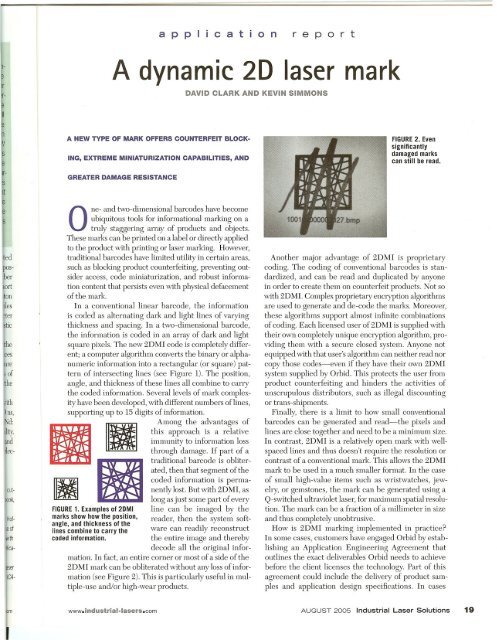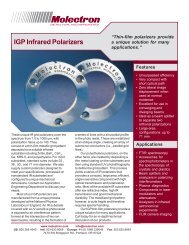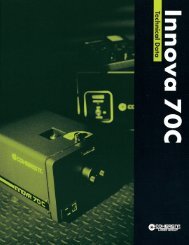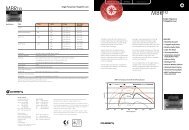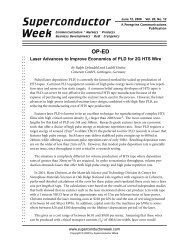A dynamic 2D laser mark - Coherent Inc.
A dynamic 2D laser mark - Coherent Inc.
A dynamic 2D laser mark - Coherent Inc.
You also want an ePaper? Increase the reach of your titles
YUMPU automatically turns print PDFs into web optimized ePapers that Google loves.
']-<br />
~r<br />
!r-<br />
ited<br />
posbel'<br />
lort<br />
ton<br />
~les<br />
~ter<br />
stie<br />
the<br />
ees<br />
ure<br />
; of<br />
the<br />
i~th<br />
)ns,<br />
rd:<br />
lility.<br />
md<br />
\lec-<br />
cut<br />
liOok,<br />
Hol<br />
:e 01<br />
with<br />
l/ica-<br />
aser<br />
ICA-<br />
a p P I cat o n report<br />
A <strong>dynamic</strong> <strong>2D</strong> <strong>laser</strong> <strong>mark</strong><br />
DAVID CLARK AND KEVIN SIMMONS<br />
A NEW TYPE OF MARK OFFERS COUNTERFEIT BLOCK-<br />
lNG, EXTREME MINIATURIZATION CAPABILITIES, AND<br />
GREATER DAMAGE RESISTANCE<br />
ubiquitous tools for informational <strong>mark</strong>ing on a<br />
O truly ne- and staggering two-dimensional array of barcodes products have and become objects.<br />
These <strong>mark</strong>s can be printed on a label or directly applied<br />
to the product with printing or <strong>laser</strong> <strong>mark</strong>ing. However,<br />
traditional barcodes have limited utility in certain areas,<br />
such as blocking product counterfeiting, preventing outsider<br />
access, code miniaturization, and robust informa<br />
tion content that persists even with physical defacement<br />
of the <strong>mark</strong><br />
In a conventional linear barcode, the information<br />
is coded as alternating dark and light lines of varying<br />
thickness and spacing. In a two-dimensional barcode,<br />
the information is coded in an array of dark and light<br />
square pixels. The new <strong>2D</strong>MI code is completely different;<br />
a computer algorithm converts the binary or alphanumeric<br />
information into a rectangular (or square) pattern<br />
of intersecting lines (see Figure 1). The position,<br />
angle, and thickness of these lines all combine to carry<br />
the coded information. Several levels of <strong>mark</strong> complexity<br />
have been developed, with different numbers of lines,<br />
supporting up to 15 digits of information.<br />
Among the advantages of<br />
this approach is a relative<br />
immunity to information loss<br />
through damage. If part of a<br />
traditional barcode is obliter<br />
ated, then that segment of the<br />
coded information is pennanently<br />
lost. But with <strong>2D</strong>MI, as<br />
long as just some part of every<br />
FIGURE 1. Examples of <strong>2D</strong>MI line can be imaged by the<br />
<strong>mark</strong>s show how the position,<br />
angle, and thickness of the<br />
lines combine to carry the<br />
reader, then the<br />
ware can readily<br />
system soft<br />
reconstruct<br />
coded information.<br />
the entire image and thereby<br />
decode all the original information.<br />
In fact, an entire corner or most of a side of the<br />
<strong>2D</strong> M I <strong>mark</strong> can be obliterated without any loss of in for <br />
mation (see Figure 2). This is particularly useful in multiple-use<br />
and/or high-wear products.<br />
FIGURE 2. Even<br />
significantly<br />
damaged <strong>mark</strong>s<br />
can still be read.<br />
Another major advantage of <strong>2D</strong>MI is proprietary<br />
coding. The coding of conventional barcodes is standardized,<br />
and can be read and duplicated by anyone<br />
in order to create them on counterfeit products. Not so<br />
with <strong>2D</strong>MI. Complex proprietary encryption algorithms<br />
are used to generate and de-code the <strong>mark</strong>s. Moreover,<br />
these algorithms support almost infinite combinations<br />
of coding. Each licensed user of<strong>2D</strong>MI is supplied with<br />
their own completely unique encryption algorithm, providing<br />
them with a secure closed system. Anyone not<br />
equipped with that user's algorithm can neither read nor<br />
copy those codes-even if they have their own <strong>2D</strong>MI<br />
system supplied by Orbid. This protects the user from<br />
product counterfeiting and hinders the activities of<br />
unscrupulous distributors, such as illegal discounting<br />
or trans-shipments.<br />
Finally, there is a limit to how small conventional<br />
barcodes can be generated and read-the pixels and<br />
lines are close together and need to be a minimum size.<br />
In contrast, <strong>2D</strong>MI is a relatively open <strong>mark</strong> with wellspaced<br />
lines and thus doesn't require the resolution or<br />
contrast of a conventional <strong>mark</strong>. This allows the <strong>2D</strong>MI<br />
<strong>mark</strong> to be used in a much smaller format. In the case<br />
of small high-value items such as wristwatches, jewelry,<br />
or gemstones, the <strong>mark</strong> can be generated using a<br />
Q-switched ultraviolet <strong>laser</strong>, for maximum spatial resolution.<br />
The <strong>mark</strong> can be a fraction of a millimeter in size<br />
and thus completely unobtrusive.<br />
How is <strong>2D</strong>MI <strong>mark</strong>ing implemented in practice?<br />
In some cases, customers have engaged Orbid by establishing<br />
an Application Engineering Agreement that<br />
outlines the exact deliverables Orbid needs to achieve<br />
before the client licenses the technology. Part of this<br />
agreement could include the delivery of product samples<br />
and application design specifications. In cases<br />
10m www.industrial-Iasers.com AUGUST 2005 Industrial Laser Solutions 19<br />
I
a p p cat o n report<br />
FIGURE 3. A UV <strong>laser</strong> <strong>mark</strong>ing system can produce miniaturized <strong>2D</strong>MI <strong>mark</strong>s as on this<br />
titanium screw head.<br />
where anti-counterfeit protection is<br />
an important benefit, a series of genuine<br />
and counterfeit <strong>mark</strong>s can be produced<br />
to prove that the Orbid system<br />
can clearly distinguish between the<br />
two. Purchase of the system requires a<br />
license fee and a per-use fee based on<br />
the number of products being <strong>mark</strong>ed.<br />
Small volume customers generally have<br />
their parts <strong>mark</strong>ed by a <strong>laser</strong> system<br />
that might be outsourced by the end<br />
customer. Higher volume customers<br />
purchase a third-party <strong>laser</strong> <strong>mark</strong>ing<br />
workstation in close cooperation with<br />
Orbid. Marks are read by conventional<br />
handheld imaging-type scanners and<br />
the information is decoded in a system<br />
computer equipped with the appropriate<br />
algorithms.<br />
Titanium medical implants<br />
Stryker Leibinger GmbH (Freiburg,<br />
Germany), a division of Stryker, has<br />
implemented <strong>2D</strong> MI <strong>mark</strong>ing to prevent<br />
counterfeiting of its products. Stryker<br />
Leibinger Micro Implants, one of the<br />
leading names in metal medical implants,<br />
specializes in small screws and plates<br />
that are used to repair fractures of the<br />
mid-face, mandible, and hand, for both<br />
neurological and reconstructive purposes.<br />
Explains Andreas Ippisch, project<br />
engineer, research & development,<br />
"Our products are used to repair tiny<br />
bones following trauma and are used<br />
in small delicate operations. In fact the<br />
biggest screw we make is only 3.2 mm x<br />
42 mm. And some of our screws are only<br />
1 mm in diameter with a 1.8 mm diame<br />
ter head and 2mm length. Our products<br />
are made from either pure titanium or<br />
titanium alloy."<br />
At first glance, this may seem to be an<br />
unlikely product-type for counterfeiting.<br />
However, these are high value products<br />
and the company has experienced problems<br />
with copies of inferior material in<br />
the <strong>mark</strong>etplace. Clearly it is not in the<br />
interest of the patient or Stryker for these<br />
unregulated copies to make their way into<br />
critical surgeries. Furthermore, the FDA<br />
requires that, if the technology is available,<br />
implant suppliers implement a product<br />
traceability system that allows product<br />
tracking from initial fabrication all<br />
the way to the patient. There is also the<br />
issue of trans-shipment where distributors<br />
may illegally divert products intended for<br />
" one country to another country in order<br />
! to avoid or reduce import duties and<br />
~ other fees.<br />
j Stryker utilizes a <strong>2D</strong>MI <strong>mark</strong>ing sys<br />
."J tern based on an all solid-state, ultravi<br />
~ olet <strong>laser</strong> (<strong>Coherent</strong> Avia). This source<br />
provides the required spatial resolution<br />
and power for making small <strong>mark</strong>s in titanium.<br />
They are using Image Team 4600<br />
PDF handheld readers to read the <strong>mark</strong>s.<br />
The company plans to use <strong>2D</strong>MI to now<br />
<strong>mark</strong> every individual component with<br />
up to 12 bits of information.<br />
The <strong>2D</strong>MI system satisfies Stryker's<br />
goal of <strong>mark</strong>ing even the tiniest of<br />
screws with a proprietary system <strong>mark</strong><br />
that can only be read by Stryker personnel,<br />
licensed agents, and customers.<br />
Ippisch explains that, "Mark miniaturization<br />
is the key for our application. On<br />
FIGURE 4. The <strong>2D</strong>MI <strong>mark</strong> can withstand cosmetic damage without information loss,<br />
which is an advantage for long-life products such as this stainless steel beer keg.<br />
20 Industrial Laser Solutions AUGUST 2005 www.industrial-Iasers.com
a screw head as small as 1.8 mm diam<br />
eter, when you allow for the size of the<br />
slots or driving notches, there is very<br />
little room left for a <strong>mark</strong>. Yet with<br />
<strong>2D</strong>MI and a UV <strong>laser</strong>, we can code<br />
15 digits of information into a <strong>mark</strong><br />
that is between 250 and 350 microns<br />
square (see Figure 3). And because<br />
we have a unique coding algorithm<br />
supplied by Orbid, no-one but Stryker<br />
and our associates can read the code<br />
or produce counterfeit products that<br />
appear as though they were made by<br />
our company."<br />
Marking stainless-steel beer kegs<br />
Trumer Brauerei, producer of Trumer<br />
Pils, an authentic European pilsner<br />
originating in Austria and brewed in<br />
Berkeley, CA, recently adopted <strong>2D</strong>MI<br />
<strong>mark</strong>ing for its stainless-steel kegs<br />
because of the <strong>mark</strong>'s durability and<br />
resistance to damage. Master Brewer<br />
Lars Larson explains, "The typical beer<br />
keg has an expected lifetime of 20 to<br />
30 years. It may be filled between two<br />
a p P I cat o n report<br />
and 10 times a year depending on the<br />
<strong>mark</strong>et, with seal changes performed<br />
after roughly every 10 fills. These beer<br />
kegs have a rough and long life, accumulating<br />
lots of scratches and dings<br />
over that lifetime. We are hoping that<br />
the <strong>2D</strong>MI system will stand up to this<br />
abuse and ultimately allow us to track,<br />
trace, and inventory everyone of our<br />
kegs. All tests so far indicate that this<br />
will be successful. The biggest challenge<br />
so far is in optimizing the scanning<br />
process. Should this technology<br />
prove itself at our brewery, there are<br />
implications for use at the other breweries<br />
within our organization, which<br />
carry larger keg fleets than Trumer."<br />
To date Trumer has <strong>mark</strong>ed about<br />
half their total of several thousand kegs<br />
(see Figure 4). These are <strong>mark</strong>ed on both<br />
the top and bottom surface. Several different<br />
sized <strong>mark</strong>s were tested for read<br />
ability, with the final choice measuring<br />
just less than 19 mill. Both the top and<br />
bottom surfaces must be <strong>mark</strong>ed because<br />
beer kegs are cleaned and filled upside<br />
down. Having a <strong>mark</strong> on the lower surface<br />
has allowed Trumer to integrate an<br />
automatic recording system that logs the<br />
kegs as they leave the filling station. The<br />
kegs are then stacked upright on pallets.<br />
They are then scanned at shipping using<br />
a handheld scanner on the top surface.<br />
And finally, returned kegs are manually<br />
scanned upon return to the brewery,<br />
before any cleaning is performed.<br />
In conclusion, the applications for<br />
<strong>laser</strong> <strong>mark</strong>ing continue to grow and<br />
diversify. The development of a new<br />
type of two-dimensional <strong>mark</strong> will add<br />
considerable value and integrity over<br />
both the traditional barcode and alphanumeric-type<br />
<strong>mark</strong>s for many diverse<br />
products. At the same time, continued<br />
advances in solid-state <strong>laser</strong>s, especially<br />
with output in the UV, means that these<br />
benefits can be realized without adding<br />
undue cost to the <strong>mark</strong>ed products. ~<br />
David Clark (david.clark@coherent.com) is<br />
with <strong>Coherent</strong> <strong>Inc</strong>. and Kevin Simmons<br />
(ksimmons@orbidcorp.com) is with Orbid Corp.<br />
www.industrial-Iasers.com AUGUST 2005 Industrial Laser Solutions 21


